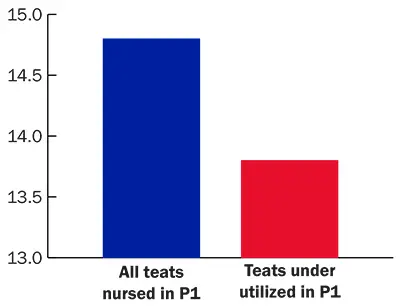
Gilt management: Practical considerations from pre-breeding to first lactation
 By Jaron Lewton
By Jaron LewtonAt Vita Plus, we constantly reassess our research and the work of others to ensure nutrition supports exceptional lifetime performance.
Beyond nutrition, proper gilt management leads to greater lifetime performance. Below are a few management considerations that are important pieces in setting up a gilt for success.
1. Boar exposure and HNS
Provide early, direct-contact boar exposure. Gilts with direct (in pen) boar exposure come into heat earlier and more consistently than those with just fence-line exposure (Zimmerman et al. 1996; Knox et al. 2021).
Graph 1. Effect of boar exposure type on gilt age at puberty (Zimmerman et al. 1996).

It is recommended to start daily exposure early and begin recording heat-no-service (HNS) dates at day 140 of age to accurately monitor timing of individual gilt estrus and to increase lifetime farrowing rate and days spent in the herd (Flowers, 2009; Knox et al. 2021).
Table 1. Impact of puberty timing on lifetime performance (Knox et al. 2021).

2. Timely breeding
Gilts should be bred on their second or third estrus cycle, and at 300 to 330 pounds (Foxcroft et al. 2003; Williams et al. 2005). Breeding gilts that are too light can decrease conception rate and reduce litter sizes; breeding gilts that are too heavy increases lifetime feed maintenance demand and leads to more locomotive/lameness issues (Williams et al. 2005; Filha et al. 2010).
Graph 2. Impact of weight at first at first service on total born through three parities (Williams et al. 2005).

3. Load up gilt litters
Lifetime milk production and teat function is highly affected by the first parity. Loading up gilts with full litters (14 healthy pigs for 14 functional teats) improves milk production during the next parity (Farmer et al. 2012). Milk production is highly correlated to piglet growth rate, so it is important to use all functional teats in the first parity.
Graph 3. Relationship of P1 teat use to wean weight in the following parity (Farmer et al. 2012).

4. Limit stress
Anything that stresses the gilt prior to breeding can increase cortisol levels and negatively impact ovulation and conception rate (Hemsworth et al. 1986). It is recommended to avoid moving, crate breaking, and/or vaccinating within three weeks of breeding. Heat stress can lead to similar effects, decreasing the onset of estrus and fetal viability (Johnson et al. 2016).
5. Flush pre-breed
Flush-feeding (ad libitum) gilts for the last 14 days prior to breeding can positively impact ovulation rate and litter size (McCaw, 2000). Flush-feeding improves the plane of nutrition just prior to breeding, but it is important to return to maintenance nutritional levels after first breeding.
About the author: Jaron Lewton is a Vita Plus swine technical sales specialist. He was raised on his family’s hobby farm in LaGrange, Indiana, and attended Huntington University to receive his bachelor’s degree in agribusiness. During this time, he gained experience in animal husbandry as a farm hand in Laos, as well as greater knowledge of the feed industry through an internship with an egg production farm, where he specialized in nutrition and feed manufacturing. Lewton then joined a management team of a 1,500-sow operation in northern Indiana before attending Michigan State University to receive his master’s degree in swine nutrition. His thesis focused on utilizing feed additives in nursery pig diets.
| Category: |
Reproduction and genetics Swine Performance |

